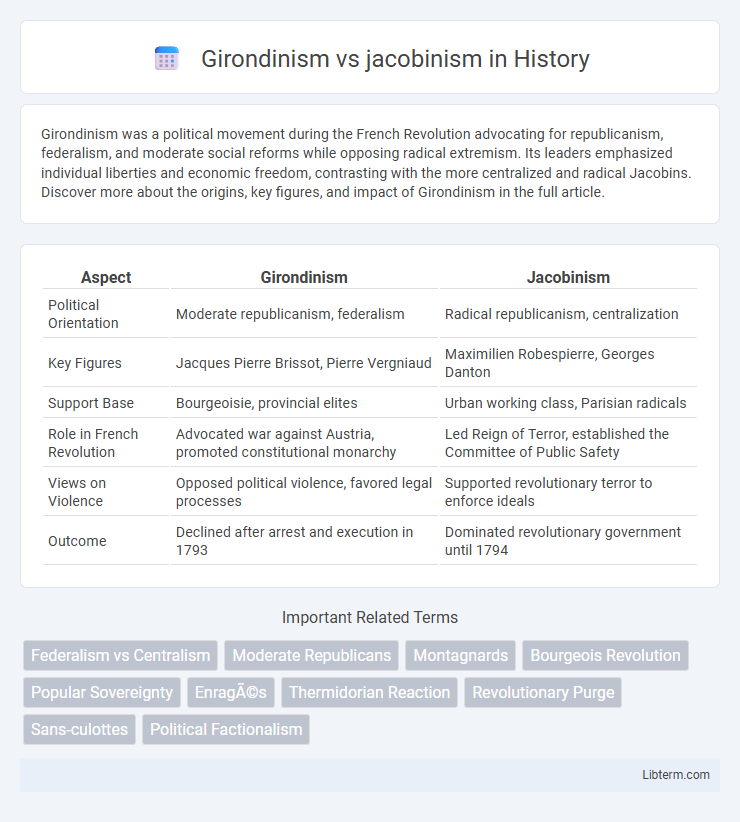Girondinism was a political movement during the French Revolution advocating for republicanism, federalism, and moderate social reforms while opposing radical extremism. Its leaders emphasized individual liberties and economic freedom, contrasting with the more centralized and radical Jacobins. Discover more about the origins, key figures, and impact of Girondinism in the full article.
Table of Comparison
| Aspect | Girondinism | Jacobinism |
|---|---|---|
| Political Orientation | Moderate republicanism, federalism | Radical republicanism, centralization |
| Key Figures | Jacques Pierre Brissot, Pierre Vergniaud | Maximilien Robespierre, Georges Danton |
| Support Base | Bourgeoisie, provincial elites | Urban working class, Parisian radicals |
| Role in French Revolution | Advocated war against Austria, promoted constitutional monarchy | Led Reign of Terror, established the Committee of Public Safety |
| Views on Violence | Opposed political violence, favored legal processes | Supported revolutionary terror to enforce ideals |
| Outcome | Declined after arrest and execution in 1793 | Dominated revolutionary government until 1794 |
Introduction to Girondinism and Jacobinism
Girondinism emerged during the French Revolution as a moderate political faction advocating for constitutional government and economic liberalism, emphasizing individual freedoms and opposition to radical centralization. Jacobinism, in contrast, represented a radical revolutionary ideology focused on centralized authority, social equality, and the use of state power to enforce revolutionary ideals, often endorsing extreme measures such as the Reign of Terror. Understanding the ideological foundations of Girondinism and Jacobinism highlights the political conflict between moderation and radicalism that shaped revolutionary France.
Historical Context: The French Revolution
Girondinism and Jacobinism represented two influential political factions during the French Revolution, reflecting distinct approaches to governance and social reform. The Girondins advocated for a more moderate republicanism, emphasizing federalism and economic liberalism, while the Jacobins supported radical centralization and the establishment of a more egalitarian society through revolutionary measures. Their conflict intensified during the Reign of Terror, ultimately leading to the Jacobins' dominance and the execution of key Girondin leaders.
Core Ideologies of Girondins
Girondinism emphasized federalism, individual liberties, and a cautious approach to revolutionary change, advocating for a decentralized government structure that protected regional autonomy. Girondins championed free-market economics and were wary of the radical measures supported by the Jacobins, promoting constitutional monarchy or moderate republicanism. Their core ideology centered on balancing revolutionary ideals with legal order and protecting property rights against populist excesses.
Core Ideologies of Jacobins
Jacobins championed radical republicanism, advocating centralized authority to enforce egalitarian policies and suppress counter-revolutionaries during the French Revolution. They emphasized democratic equality, secularism, and state control over the economy to promote social justice and eradicate aristocratic privileges. This contrasted sharply with Girondinism, which favored federalism, economic liberalism, and a more moderate approach to political change.
Key Leaders and Influential Figures
Key leaders of Girondinism included Jacques Pierre Brissot and Jean-Marie Roland, who advocated for federalism and moderate revolutionary reforms. Influential figures of Jacobinism featured Maximilien Robespierre and Georges Danton, proponents of centralized authority and radical republicanism. The ideological split between these leaders underscored the broader conflict between moderate and radical factions during the French Revolution.
Political Strategies and Methods
Girondinism favored moderate political strategies emphasizing federalism, individual liberties, and economic liberalism, relying on parliamentary debate and diplomatic negotiations. Jacobinism adopted radical methods centered on centralized authority, mass mobilization, and revolutionary justice, often utilizing popular violence and repression to enforce political goals. The Girondins sought broader consensus through political discourse, while the Jacobins prioritized direct action and the consolidation of power to maintain the Revolution's momentum.
Economic Policies and Visions
Girondinism emphasized free-market principles, advocating for limited government intervention and support for agriculture and commerce to stimulate economic growth. Jacobinism prioritized state control over the economy, promoting centralized planning, price controls, and requisitioning to support wartime needs and social equality. These contrasting economic policies reflected Girondins' commitment to liberal capitalism versus Jacobins' preference for economic regulation and redistribution.
Social and Cultural Perspectives
Girondinism emphasized moderate republicanism and valued individual liberties, promoting decentralized governance that favored the provincial bourgeoisie and merchants. Jacobinism championed radical egalitarianism and centralized authority, advocating for strong state intervention to achieve social equality and cultural uniformity aligned with revolutionary ideals. Socially, Girondins sought gradual reform and economic freedom while Jacobins pursued aggressive measures to suppress counter-revolutionary elements and enforce civic virtue.
Major Conflicts and Outcomes
Girondinism championed a federalist vision, promoting decentralized governance and liberty, while Jacobinism pushed for centralized authority and radical republicanism, leading to fierce political clashes during the French Revolution. Major conflicts peaked during the Reign of Terror when Jacobins, under Robespierre, orchestrated purges against Girondin leaders, resulting in executions and the consolidation of Jacobin power. The outcome solidified Jacobin dominance yet sowed seeds for future republican debates on balance between centralized control and regional autonomy.
Lasting Legacy and Historical Impact
Girondinism championed federalism and moderate republicanism, influencing the development of decentralized governance in post-revolutionary France and modern democratic institutions. Jacobinism, characterized by radical centralization and egalitarianism, left a lasting legacy in shaping revolutionary extremism and state-led social reforms. The enduring historical impact of these opposing factions is evident in contemporary debates over the balance between centralized authority and regional autonomy.
Girondinism Infographic

 libterm.com
libterm.com